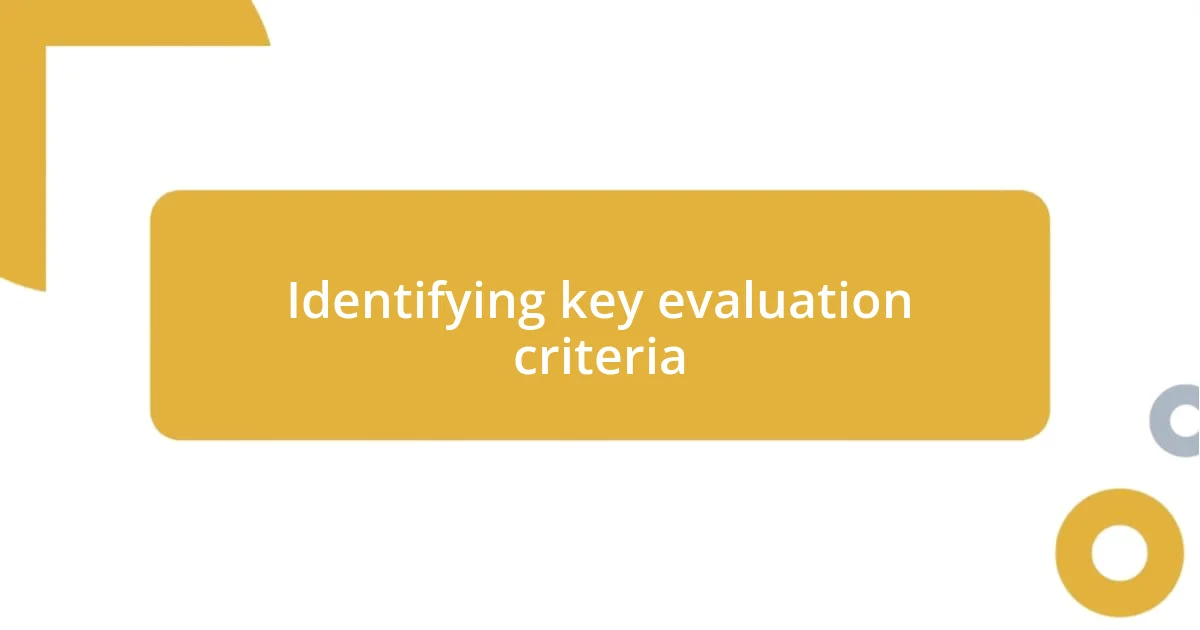Key takeaways:
- Understanding e-learning software features, such as learner progress tracking and social interaction, enhances the learning experience significantly.
- Key evaluation criteria include usability, multimedia resources, and support systems, as they directly impact the effectiveness of online learning.
- Researching user reviews and integration capabilities is crucial for selecting reliable software that meets both educational and practical needs.

Understanding e-learning software features
When I first began exploring e-learning software, I quickly realized that understanding its features is crucial for effective learning. It’s like walking into a candy store; the sheer variety can be overwhelming. Have you ever felt lost among endless options? I certainly did at first, but focusing on user interface and customization helped me narrow down my search.
One feature that really stood out to me was the ability to track learner progress. I remember how satisfying it was to see visual representations of my achievements and areas for improvement. This not only motivated me but also provided insights into my learning patterns. Isn’t it fascinating how data can drive our learning experience?
Then there’s the social interaction aspect within e-learning platforms. The first time I participated in a discussion forum, I felt a sense of community that I hadn’t expected from an online setting. Sharing ideas and getting feedback from peers added a layer of depth to my learning that I didn’t realize I was missing. Don’t you agree that learning together can enhance understanding in ways that solitary study cannot?

Identifying key evaluation criteria
Identifying key evaluation criteria is essential for anyone venturing into the realm of e-learning software. One of the first criteria I considered was usability. I distinctly remember a platform that was so cluttered, I felt more lost than enlightened. User-friendly navigation makes all the difference, enabling learners to focus on content rather than grappling with complex interfaces. Have you experienced the frustration of navigating a complicated platform? I certainly bore that weight early on, and it made a significant impact on my learning journey.
Another crucial aspect for me was the availability of multimedia resources. I vividly recall engaging with a training course that incorporated videos, podcasts, and interactive quizzes. This variety transformed how I absorbed information—rather than just reading text, I was actively participating. With these engaging elements, I found it easier to grasp complex concepts. How do you prefer to learn? Understanding your own style can illuminate what features matter most to you.
Lastly, I can’t stress enough the importance of support systems—for both learners and instructors. Once, I was stuck on a concept in an online course, and timely support from a knowledgeable instructor made all the difference. Having access to live chat or forums can greatly enhance the learning experience. What support options do you look for in an e-learning platform? They can be game-changers when you need guidance.
| Evaluation Criteria | Description |
|---|---|
| Usability | Importance of user-friendly navigation for effective learning. |
| Multimedia Resources | Diversity of engaging content types that cater to various learning styles. |
| Support Systems | Availability of help options for learners and instructors. |

Researching user reviews and ratings
When I started evaluating e-learning software, diving into user reviews and ratings felt like uncovering hidden treasures. I remember one particular platform that seemed promising based on marketing claims, but the multitude of negative reviews opened my eyes. It was disheartening to read about others struggling with glitches and poor customer support. The emotional weight of those stories made me more discerning; I wanted a software that truly delivered on its promises.
Here are some key points I’ve gathered from my experience:
- Credibility of Reviews: I found reviews on independent sites to be more trustworthy than those on the software’s own website.
- Common Themes: Identifying patterns in feedback—such as repeated mentions of great user support or frequent technical issues—helped me gauge overall reliability.
- Number of Ratings: The quantity of ratings often indicated the software’s popularity and real-world application, giving me a clearer context of its effectiveness.
Reading reviews not only guided my selection process but also resonated with me emotionally. I wanted a tool that could empower my learning just as strongly as those who shared their journeys.

Testing usability and user experience
Testing usability and user experience is where the rubber meets the road in evaluating e-learning software. I distinctly recall a platform that boasted intuitive design, yet I found myself clicking aimlessly. A glaring lack of user-friendly features can be frustrating, turning what should be an educational journey into a puzzling maze. Have you ever felt like the software was more of a barrier than a gateway? I’ve been there, and it’s a sentiment that drives my approach to usability.
In my experience, testing navigation and accessibility features is crucial. I once encountered an e-learning tool where the course materials were hidden behind several confusing menu layers. It was like following a breadcrumb trail that led to nowhere! A simple, straightforward layout allows learners to engage effectively without being sidetracked by technical hurdles. What does a seamless user experience feel like to you? For me, it’s the easy flow of finding resources and staying focused.
Ultimately, I believe that a practical evaluation should include real-time user experience testing. I recall a situation where, during group training, we tried using a platform together. The realization hit me hard—some users struggled while others flowed effortlessly. This variance highlighted how individual needs vastly impact the user experience. Engaging multiple users in testing can provide valuable perspectives, ensuring that the software meets a diverse range of learning styles. How do you think your experience would differ if you had a chance to test a platform before committing? That firsthand interaction can be invaluable.

Assessing integration capabilities
When it comes to assessing integration capabilities, I always look for how well the e-learning software plays with other tools I already use. I vividly remember integrating a new platform with my existing Learning Management System (LMS). The process felt like a dance—sometimes in sync, but often with missteps that caused frustration. Have you experienced that awkward moment when the software doesn’t connect, leaving you scrambling for alternatives? It’s disheartening, especially when you’re relying on a seamless setup for effective teaching.
I also find it crucial to evaluate the API (Application Programming Interface) documentation provided by the software. One time, I landed on a platform whose API was poorly documented, making integration feel like piecing together a jigsaw puzzle with missing parts. That experience left me wondering how much time I could have saved with clearer guidance. A solid integration capability can truly enhance a learning environment, allowing technology to work for us, not against us.
Additionally, I seek input from fellow educators on their integration experiences. I once chatted with a colleague who shared her success integrating a tool with automated report generation. The look of relief on her face as she shared how much time it saved her was truly telling. It made me realize that efficient integration isn’t just a technical aspect; it can significantly impact productivity and stress levels. When evaluating software, I’ve learned to ask not only how it integrates but also how that integration can enhance our overall teaching approach.

Evaluating pricing and support options
When evaluating pricing, I often find myself asking, “What am I really getting for my investment?” I remember a time when I purchased a seemingly affordable e-learning platform, only to discover hidden costs lurking in the fine print. Licenses for additional users and extra features piled up quickly, and my budget took an unexpected hit. Have you ever felt misled by an attractive price tag? It’s a situation that can leave you feeling uneasy about your choices.
Support options are just as crucial as pricing. I once chose a platform based on its competitive pricing, only to find that the support was lacking. When technical difficulties arose, reaching customer service felt like trying to swim upstream—tedious and frustrating. I learned the hard way that having a responsive support team can make or break the learning experience. How important is immediate assistance to you when a problem arises? In my view, it’s essential to have solid support that makes you feel heard and valued.
Additionally, I often consider the long-term investment of e-learning software. I recall a platform that required an annual commitment but provided excellent customer support and regular updates, which ultimately justified the cost. It made me realize that sometimes, spending a bit more initially pays off significantly in the long run. Pricing isn’t just about the upfront costs; it’s about the overall value and support that comes with it. Wouldn’t you agree that a well-rounded approach to pricing and support is key to fostering a successful learning environment?













